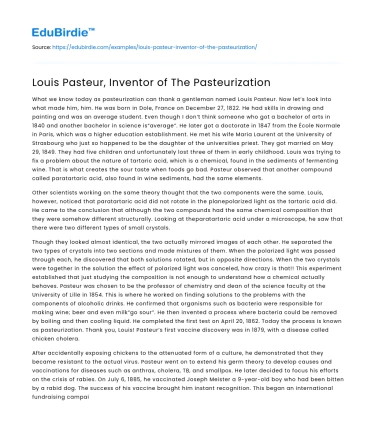What we know today as pasteurization can thank a gentleman named Louis Pasteur. Now let’s look into what made him, him. He was born in Dole, France on December 27, 1822. He had skills in drawing and painting and was an average student. Even though I don’t think someone who got a bachelor of arts in 1840 and another bachelor in science is“average”. He later got a doctorate in 1847 from the École Normale in Paris, which was a higher education establishment. He met his wife Maria Laurent at the University of Strasbourg who just so happened to be the daughter of the universities priest. They got married on May 29, 1849. They had five children and unfortunately lost three of them in early childhood. Louis was trying to fix a problem about the nature of tartaric acid, which is a chemical, found in the sediments of fermenting wine. That is what creates the sour taste when foods go bad. Pasteur observed that another compound called paratartaric acid, also found in wine sediments, had the same elements.
Other scientists working on the same theory thought that the two components were the same. Louis, however, noticed that paratartaric acid did not rotate in the planepolarized light as the tartaric acid did. He came to the conclusion that although the two compounds had the same chemical composition that they were somehow different structurally. Looking at theparatartaric acid under a microscope, he saw that there were two different types of small crystals.
Save your time!
We can take care of your essay
- Proper editing and formatting
- Free revision, title page, and bibliography
- Flexible prices and money-back guarantee
Though they looked almost identical, the two actually mirrored images of each other. He separated the two types of crystals into two sections and made mixtures of them. When the polarized light was passed through each, he discovered that both solutions rotated, but in opposite directions. When the two crystals were together in the solution the effect of polarized light was canceled, how crazy is that!! This experiment established that just studying the composition is not enough to understand how a chemical actually behaves. Pasteur was chosen to be the professor of chemistry and dean of the science faculty at the University of Lille in 1854. This is where he worked on finding solutions to the problems with the components of alcoholic drinks. He confirmed that organisms such as bacteria were responsible for making wine; beer and even milk“go sour”. He then invented a process where bacteria could be removed by boiling and then cooling liquid. He completed the first test on April 20, 1862. Today the process is known as pasteurization. Thank you, Louis! Pasteur’s first vaccine discovery was in 1879, with a disease called chicken cholera.
After accidentally exposing chickens to the attenuated form of a culture, he demonstrated that they became resistant to the actual virus. Pasteur went on to extend his germ theory to develop causes and vaccinations for diseases such as anthrax, cholera, TB, and smallpox. He later decided to focus his efforts on the crisis of rabies. On July 6, 1885, he vaccinated Joseph Meister a 9-year-old boy who had been bitten by a rabid dog. The success of his vaccine brought him instant recognition. This began an international fundraising campaign to build the Pasteur Institute in Paris, which was inaugurated on November 14, 1888.






 Stuck on your essay?
Stuck on your essay?

